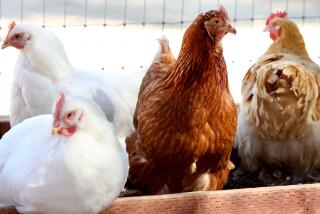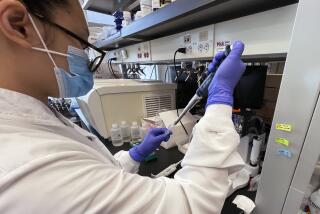Bacteria In Chicken Is ‘Understated’
- Share via
Bacteria levels in uncooked chicken are “grossly understated” by federal officials, according to an internal U.S. Department of Agriculture document recently published by a food industry trade journal.
The memo found fault with established methods of calculating the number of bacteria, including salmonella, present on chickens at processing plants.
The report, resulting from a study aimed at reducing poultry contamination, indicates that current detection methods may be isolating only about 14% of the micro organisms present on broilers.
USDA officials downplayed the importance of the findings, however, saying that the information was preliminary in nature and had not been scientifically reviewed.
Early Publication
The report was prepared by the department’s Agricultural Research Service in Athens, Ga., and was intended solely for the Food Safety and Inspection Service, the division responsible for overseeing meat and poultry processing.
Once completed, though, the survey was obtained and published by Food Chemical News, a Washington-based journal.
Karen Stuck, chief information officer for the USDA’s Food Safety and Inspection Service in Washington, said, “This issue has not even been reviewed yet.”
“Certainly, (these findings) are something that we are interested in, but we have no formal response to the report, nor do we contemplate any changes (in processing requirements), nor do we have any thoughts along those lines,” Stuck said.
The Agriculture Research Service simply reports on its studies, she added, and does not make any policy decisions in the food safety field.
Even so, the recent, unauthorized publication of the report is a setback for the poultry industry. It comes at a time when producers are still reeling from a National Academy of Sciences survey, released earlier this year, that found more than one-third of all birds heading for retail channels contain salmonella, a harmful bacteria.
Poultry industry representatives originally countered the contamination statistics by claiming that the number of salmonella organisms present on chickens, if any, is minuscule.
Less Credible Claim
Now, in the face of the Athens, Ga., research, it appears that such a claim is less credible.
If, in fact, the amount of salmonella bacteria on birds is substantially higher than was previously believed, then larger numbers of individuals would be susceptible to illness if exposed to the pathogen through improper storage, handling or cooking of the meat.
“(Previous) counts reported by other researchers who have sampled poultry (for bacteria) are probably underestimated . . . after what my work showed,” said Huda S. Lillard Ph.D., a food technologist who directed the Athens, Ga., study for the USDA’s Agriculture Research Service.
Lillard says that the standard method of measuring bacteria on processed chicken takes into account only the number of organisms detected in water after the liquid is used to rinse the bird’s exterior and cavity. Lillard, however, continued to rinse carcasses as many as 40 times and still recovered bacteria.
A portion of the USDA memo reprinted by Food Chemical News stated: “Once on the carcass, Salmonellae were protected by seeming to lodge in crevices formed on the (chicken’s) skin following water immersion.”
The salmonella issue became a problem for the poultry industry earlier this year when the National Academy of Sciences estimated that between 35% to 37% of the nation’s chicken contained salmonella, a pathogen that can cause nausea, vomiting and fever. The bacteria can be fatal for individuals with compromised immune systems such as infants, the elderly, cancer patients and those suffering from AIDS. It is these high-risk groups who would be especially susceptible to larger numbers of bacteria.
A Need for Caution
Typically, a contaminated carcass was thought to contain 30 to 100 salmonella organisms. Lillard’s work indicates that these figures could be multiplied seven or eight times to discern the actual number present. Although there is disagreement among health officials, some say as few as 10 salmonella organisms can cause illness in people with weakened immune systems.
“What the USDA should now do is find various ways of preventing contamination,” said Rod Leonard, executive director of the Community Nutrition Institute, a consumer-advocacy group in Washington. “Such an effort should look at how flocks are grown and also find better mechanical processes in the slaughtering of the birds.”
Salmonella is estimated to be the cause of more than 2 million illnesses annually in this country, only a portion of which are linked directly to chicken.
Nevertheless, health officials recommend that consumers assume that all raw meats are contaminated and wash any surfaces that come in contact with the meat prior to cooking--including cutting surfaces, knives, other utensils and hands. Chickens should also be cooked until well done.
More to Read
Sign up for Essential California
The most important California stories and recommendations in your inbox every morning.
You may occasionally receive promotional content from the Los Angeles Times.













